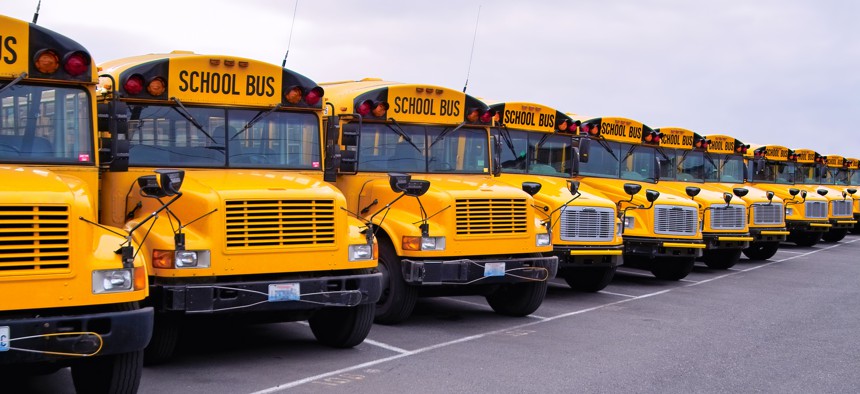Schools Find Power in Numbers

jhorrocks via Getty Images
Across the country, school districts are joining together to negotiate lower premiums for insurance, goods and services.
Between a shortage of bus drivers and the small number of buses that the Old Rochester Regional School District employs in Mattapoisett, Massachusetts, if a bus driver calls in sick for the afternoon sports program, one of the teams loses their ride to a game.
“We have to have the conversation: Well, which team hasn’t missed a game?” said Howie Barber, assistant superintendent of finance and operations.
So, to save money and increase the number of buses and drivers in the fleet, next year Barber will bid with other towns in his district on more than 20 buses—up from the six to eight buses his district currently operates. It requires getting over the mindset that each elementary school represents its own organization, he said.
Old Rochester’s newfound partnership illustrates a growing trend around the nation in which school districts and their municipalities band together to get the best prices on goods and services.
“Anecdotally, I’m seeing it as a trend. It makes sense to come together to negotiate,” said Elleka Yost, director of advocacy for the Association of School Business Officials International, based in Ashburn, Virginia. “Cooperative purchasing creates economies of scale for a whole range of services—food services, payroll, IT—each district has its own situation.”
Districts are also joining forces with each other and with some of their states to negotiate for better rates as the cost of health and other insurances climb steadily.
In Connecticut, a teacher who works in one of the 16 schools run by the Capitol Region Education Council had a baby who was born with cancer, said Sandy Cruz-Serrano, CREC’s deputy executive director. The “stop-loss” insurance, necessary to protect employers against crippling costs in the event of a catastrophic claim. was too expensive for CREC to buy on its own. So it joined with eight other districts to create a stop-loss insurance cooperative, Cruz-Serrano said, and it made the insurance more affordable.
Inflation and labor shortages are driving these new partnerships.
“Our state has 169 towns and 160 school districts. Nobody wants anybody encroaching on their territory,” Cruz-Serrano said. Nobody wants to give an inch. But now, because everything is so expensive, school districts are seeing the light. Lots of districts are seeing the benefit of merging services. The labor shortage is real.”
Officials at some of the largest districts in California and Long Island, New York, already have the scale they need or have long participated in cooperatives that negotiate prices that others can piggyback on. But for many—even those in existing regional school districts such as the Old Rochester district—the practice is new.
Barber said he realized during the pandemic that the schools needed to assign a computer to each child, but they didn’t have enough of them. The towns in the district were accustomed to buying their own technology for the schools they run. By including all the elementary and middle schools into the regional high school’s purchase, they enlarged their order to 1,800 Chromebooks, 200 Macbooks and 200 Promethean boards that hook up to teachers’ computers in the classrooms. “We saved at least $75,000,” he said.
Now that the individual districts within the regional high school district understand the savings they can realize by joining their bargaining groups, Barber said, they’ll continue to find more ways to save money together.
Some states are stepping in to lend the leverage that comes with size. Beginning in 2016, the state of Connecticut, for example, opened its health insurance policy to every public school district, municipality, and fire and police department in the state as long as the entire group opts in.
“We can use our bargaining power as the largest unit in the state to negotiate better rates,” said Madi Csejka, press secretary for the state comptroller.
Today, nearly 60,000 teachers, firefighters, police officers, and municipal employees and their families use the state plan. Bargaining units throughout the state range in size from one person who works at a small library to more than 8,000 employees in Bridgeport, one of the state’s major cities.
“The first responders, teachers and plow drivers … deserve affordable and quality health care and they get it through the partnership plan,” said Connecticut Comptroller Sean Scanlon in a report on the plan.
Connecticut conducted a survey last fall and found that 15 other states in the nation similarly open their state plans to municipal and school districts, Csejka said, including Alabama, Delaware, Indiana, Kansas, Kentucky, Maryland, Massachusetts, Minnesota, Missouri, Oregon, South Carolina, Tennessee, Vermont, West Virginia and Wisconsin.
Superintendents in California, New York, Connecticut and elsewhere also talked about the importance of piggybacking off contracts other districts negotiate. “It provides buying power,” said Jack R. Mitchell, assistant superintendent for business in Valley Stream, New York.
Cruz-Serrano said her district operates a cooperative purchasing marketplace for 35 participating districts. “Even some Massachusetts towns buy from our contracts,” she said. “We open it up on purpose. We want to make sure districts get the best prices.”
Everything in the marketplace goes out for new bids when contracts expire, Cruz-Serrano said, and districts can find whatever they need, including turf fields. She said that private schools haven’t made use of the marketplace, but they’re welcome to join.
“The more districts can pull together their bargaining power, the better their purchasing power to negotiate with companies for lower rates,” said Yost of the Association of School Business Officials.
Barber likened the power of purchasing partnerships to the difference between buying small amounts of goods at specialty stores or “going to Costco.”





